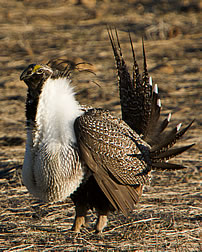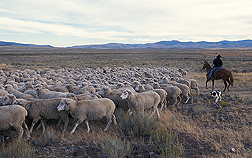This page has been archived and is being provided for reference purposes only. The page is no longer being updated, and therefore, links on the page may be invalid.
Read the magazine story to find out more. |
|
Idaho Research Station Helps Beleaguered Bird
By Erin PeabodyNovember 13, 2006
They whistle, puff their chests and strut like peacocks. But for all their attention-getting efforts, greater sage grouse are slowly disappearing from the American West. Once estimated to be in the millions, the birds may now number only about 150,000.
There's one group of researchers, though, that hasn't forgotten about the grouse: Agricultural Research Service (ARS) scientists in Dubois, Idaho.
There, at the agency's U.S. Sheep Experiment Station, researchers have been tracking the bird for more than 40 years. While their focus is sheep production, scientists at the sprawling 50,000-acre station make certain to include the needs of wildlife in their management plans.
The sage grouse, a favorite of bird enthusiasts and wildlife photographers, is probably best known for its elaborate mating ritual. Every spring, the birds engage in a lot of wing-swishing, chest-puffing and whistling to attract potential mates.
To carry out this colorful ritual, grouse need sagebrush and a variety of other high-altitude, mountain-loving plants for food and protection. Situated in southeastern Idaho, in the shadow of the Centennial Mountains, the ARS research station is home to lots of sagebrush—of the right kinds and ages.
According to Dubois research leader Gregory Lewis, a monoculture of thick, burly sage isn't inviting to birds. Instead, what draws the grouse—as well as deer, elk, pronghorn antelope and moose—is rich, layered vegetation.
Lewis drafts some unlikely assistants to help create this favorable habitat: the station's 3,000 sheep. The animals' hooves and jaws open up thick, unruly sage brush stands so that more diminutive plants can take root. Lewis and his team also prescribe regular burns to further rejuvenate the soil and encourage tender, green plant growth.
According to Lewis, these primary tools—sheep and fire—have helped boost the station's greater sage grouse population.
Read more about this and other ARS wildlife conservation efforts in the November/December 2006 issue of Agricultural Research magazine.
ARS is the U.S. Department of Agriculture's chief scientific research agency.


